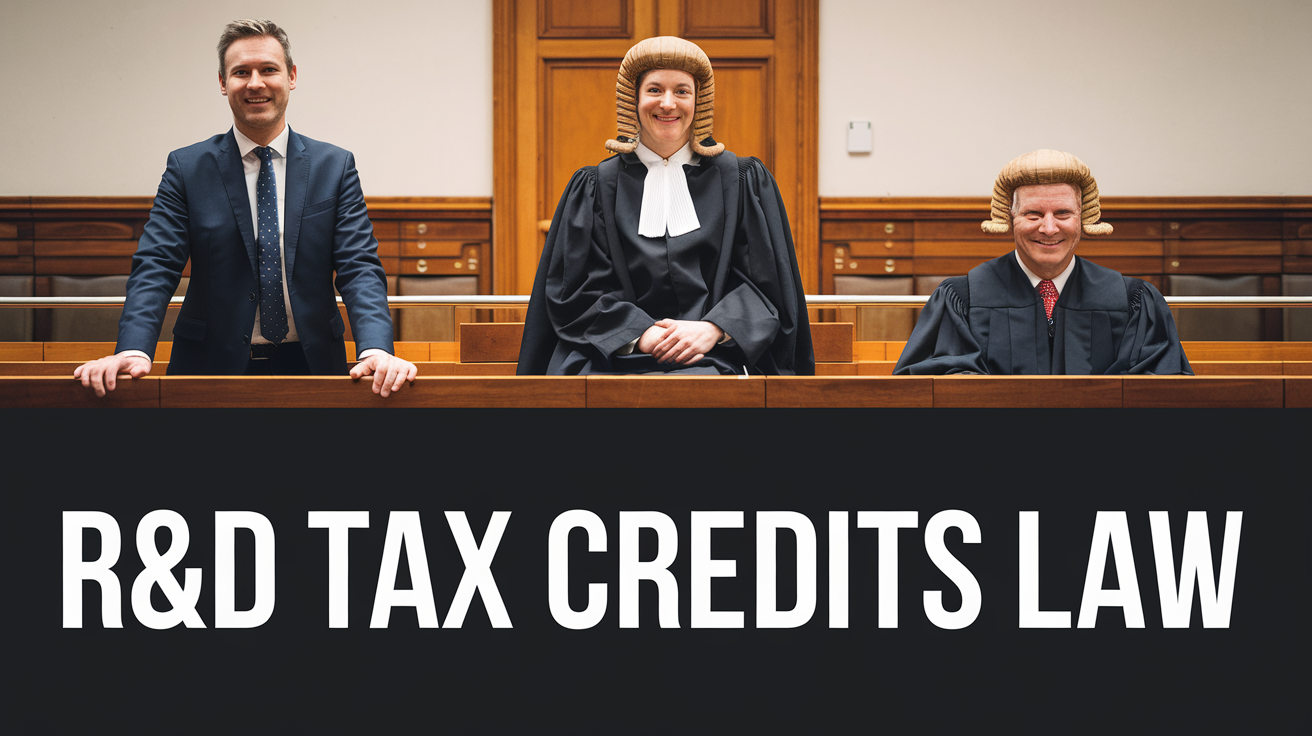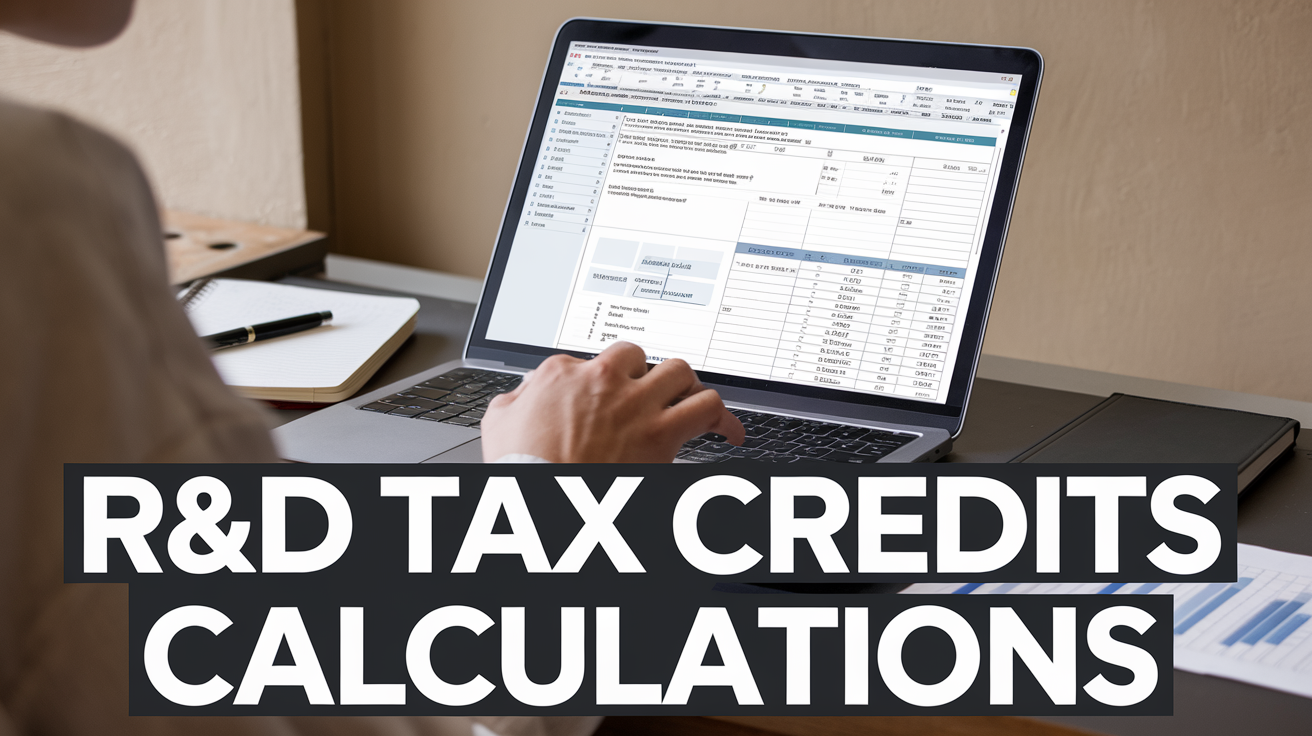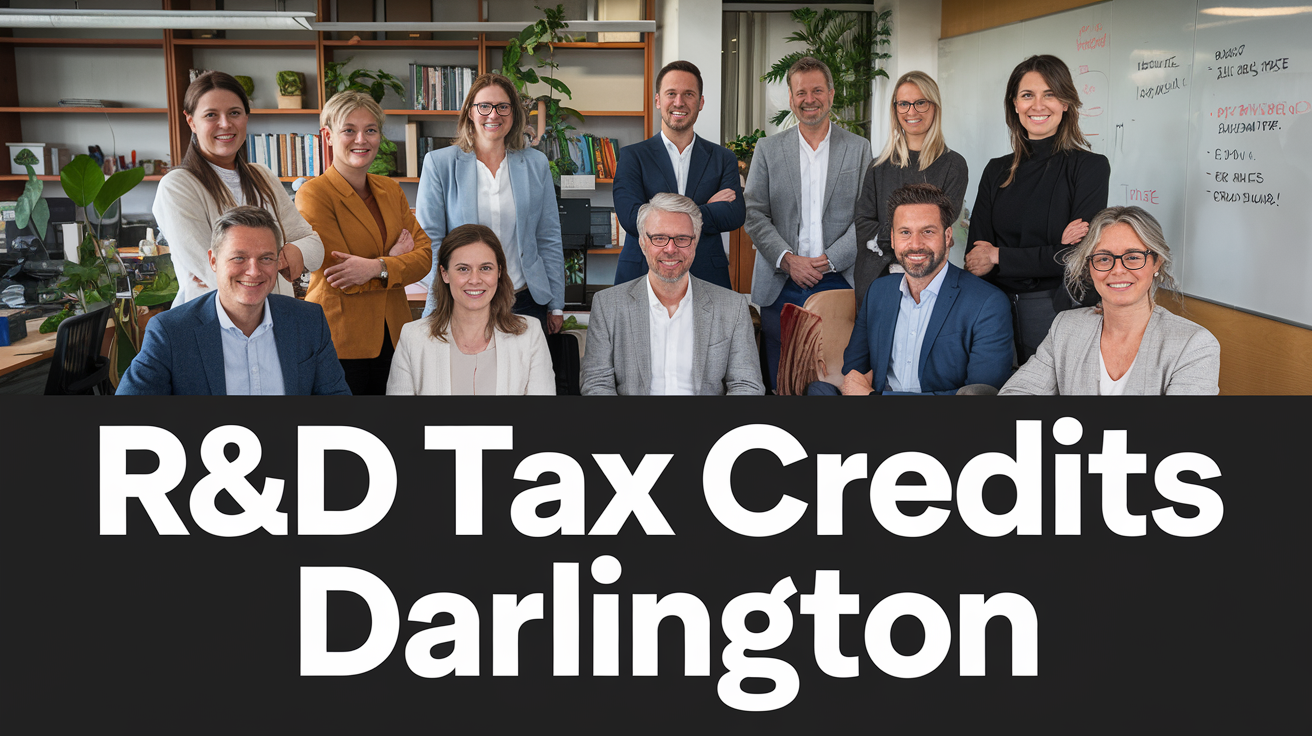R&D Tax Credits Darlington Durham
R&D tax credits in Darlington, Durham, are a valuable corporation tax incentive provided by HMRC to encourage companies to invest in innovation and research. These credits can significantly reduce a company's tax liability or even generate refunds, making them a crucial financial tool for businesses engaged in scientific and technological advancements.
By claiming R&D tax credits, Darlington businesses can benefit financially and competitively. The credits allow companies to offset their tax liability, improving their cash flow and enabling them to allocate more resources to R&D initiatives. This can lead to the development of new products, processes, and technologies, giving businesses a competitive edge in their respective markets. R&D Tax Credits UK can guide you through the process, ensuring you maximize your eligible expenses and comply with all necessary criteria set by HMRC.

How Do R&D Tax Credits Benefit Darlington Businesses?
R&D tax credits can significantly benefit Darlington businesses by providing substantial tax savings and fostering innovation. These credits allow businesses to offset their tax liability, thereby improving their financial health and cash flow.
Financial Advantages
R&D tax credits offer Darlington businesses a financial boost by allowing them to claim a taxable credit for expenditure incurred on eligible R&D activities. For instance, RDEC (Research and Development Expenditure Credit) enables companies to claim a 20% taxable credit on eligible expenditure, which can be used to settle corporation tax liabilities or other tax debts.
This credit can be particularly beneficial for small and medium-sized enterprises (SMEs) that invest heavily in R&D. SMEs can claim an additional deduction of up to 186% of their R&D expenditure, and in cases where this results in a trading loss, they may be eligible for a repayable credit of 14.5%.
Competitive Edge in Innovation
R&D tax credits give Darlington businesses a competitive edge in innovation by incentivizing the development of new products, processes, and technologies. These credits encourage companies to engage in research activities that address scientific or technological uncertainties, thereby driving innovation and improving overall industry knowledge.
By claiming R&D tax credits, businesses can allocate more resources to R&D initiatives, which can lead to the creation of new intellectual property, patents, and improved products. This not only enhances their innovative capabilities but also positions them more competitively in their respective markets.

Which Industries Commonly Claim R&D Tax Credits?
Companies across various industries in the UK can claim R&D tax credits if they are involved in innovative projects that seek to advance science or technology. The eligibility for R&D tax credits is not limited to specific sectors, but some industries are more likely to qualify due to the nature of their work.
Technology Sector
The technology sector is a significant beneficiary of R&D tax credits. Companies developing new software, hardware, or IT solutions often qualify for these credits. For example, firms working on artificial intelligence, cybersecurity, or data analytics can claim relief on their R&D expenditure.
Manufacturing
Manufacturing companies also frequently claim R&D tax credits. These companies often engage in projects to improve existing products, develop new manufacturing processes, or create innovative materials. Such activities, which involve overcoming scientific or technological uncertainties, are eligible for R&D tax relief.
Life Sciences
The life sciences industry, including pharmaceuticals, biotechnology, and medical devices, is another sector that commonly claims R&D tax credits. Companies in this field often conduct extensive research and development to create new treatments, drugs, or medical equipment, all of which can qualify for tax relief.
Others
In addition to these sectors, other industries such as aerospace, automotive, and energy also claim R&D tax credits. Any company that invests in research and development to advance science or technology, regardless of the sector, may be eligible for these credits. This includes companies working on sustainable energy solutions, advanced materials, or innovative engineering projects.

What Qualifies as R&D Under UK Tax Law?
To qualify as research and development (R&D) under UK tax law, your project must be seeking an advance in science or technology by overcoming scientific or technological uncertainties. This advance must benefit the field overall, not just your business.
Qualifying Activities
Qualifying R&D activities involve projects that aim to resolve scientific or technological uncertainties that are not readily deducible by a competent professional in the field. These activities can include developing new products, processes, materials, services, or devices, as well as enhancing existing ones.
- Staff Costs: Salaries, employer’s NIC, pension contributions, and reimbursed expenses for staff involved in R&D activities qualify for tax relief.
- Subcontractors and Freelancers: Costs associated with subcontractors and freelancers working on R&D projects are also eligible.
- Materials and Consumables: Costs of materials, heat, light, and power used up or transformed by the R&D process can be claimed.
- Software and Data Costs: Software licences and certain data and cloud costs related to R&D activities are qualifying expenses.
Excluded Activities
Activities that do not qualify for R&D tax relief include those that do not involve overcoming scientific or technological uncertainties. Here are some examples:
- Non-Scientific/Technological Uncertainties: Work focused on resolving uncertainties in the arts, humanities, social sciences, or other non-scientific fields does not qualify.
- Routine Business Activities: Activities such as routine testing, quality control, and routine software development do not meet the criteria.
- Certain Industries: Activities from care homes, childcare providers, personal trainers, wholesalers, retailers, pubs, and restaurants are generally not eligible for R&D tax credits.

How Are R&D Tax Credits Calculated?
R&D tax credits are calculated based on the qualifying research and development expenditure of your company, with different schemes applying to small and medium enterprises (SMEs) and larger companies. The calculation varies depending on whether your company is profitable or loss-making and the date of the expenditure.
SME Scheme
For SMEs, which are defined as companies with fewer than 500 employees and a turnover of under €100 million (or €86 million net assets), the calculation involves enhancing the qualifying R&D expenditure.
Pre-April 2023:
- If your company is profitable, you can claim an additional 130% on qualifying R&D expenditure. For example, £100 spent on R&D becomes £230 after enhancement. With a corporation tax rate of 19%, this results in a tax credit of £24.70 for every £100 spent.
- If your company is loss-making, you can surrender the enhanced expenditure for a cash payment. The enhanced expenditure is 230% of the qualifying R&D costs, and the credit rate is 14.5%, resulting in £33.35 for every £100 spent.
Post-April 2023:
- For profitable companies, the enhancement rate reduces to 86%, and the corporation tax rate increases to 25% for companies with over £250,000 in profits. This results in a tax credit of £21.50 for every £100 spent.
- For loss-making companies, the enhancement rate is 186%, and the credit rate reduces to 10%, resulting in £18.60 for every £100 spent.
RDEC Scheme
The Research and Development Expenditure Credit (RDEC) scheme is for larger companies or those that do not meet the SME criteria.
Pre-April 2023:
- Companies can claim 13% of their qualifying R&D expenditure as a taxable credit. For example, £100 spent on R&D results in a £13 credit, with a net benefit of £10.53 after tax.
Post-April 2023:
- The RDEC rate increases to 20%, so £100 spent on R&D results in a £20 credit, with a net benefit of £15 after tax.

What Are the Recent Changes to UK R&D Tax Credits?
The UK R&D tax credit system has undergone significant changes, particularly following the 2023 Autumn Statement. These changes aim to simplify the system, reduce errors, and curb fraud.
Policy Updates
- Merged Scheme: The SME R&D Tax Relief and the RDEC scheme have been merged into a single scheme, applicable for accounting periods beginning on or after April 1, 2024. This merger is intended to simplify the process and make it more uniform.
- R&D Intensive SMEs: Loss-making SMEs that spend more than 30% of their total expenditure on R&D are classified as 'R&D Intensive' and are eligible for a higher tax credit rate of 27%. This threshold has been reduced from the previous 40%.
- Tax Credit Rates: The merged scheme has a tax credit rate of 20%, while R&D intensive SMEs can receive up to a 27% tax credit. For profit-making companies, the effective rate after tax is between 15% and 16.2%, depending on the corporation tax rate.
- PAYE and NIC Cap: A relief cap based on PAYE and NIC has been introduced to ensure the tax relief benefits UK companies and contractors. This cap applies to all businesses under the merged scheme.
- UK Territoriality Restriction: Expenditure on externally provided workers and subcontracting arrangements must be restricted to UK-based activities to qualify for the tax credits.
Impact on Businesses
- Simplified Process: The merger of the SME and RDEC schemes is designed to simplify the application process for R&D tax credits, reducing the complexity and errors associated with multiple schemes.
- Reduced Benefits for Some SMEs: Prior to the changes, loss-making SMEs could claim up to a 33.35% effective tax relief rate. However, this has been reduced to 18.6% for periods before April 2024, and now stands at 27% for R&D intensive SMEs under the new scheme.
- Increased Compliance: HMRC has tightened compliance measures to address non-compliant claims and misuse of the system. This means businesses need to ensure their claims are thoroughly legitimate and accurately prepared, often requiring professional advice.
- Grace Period for R&D Intensive Status: Businesses classified as R&D intensive can maintain this status for a grace period of one year, even if their R&D expenditure drops below the 30% threshold for one accounting period.

How Can Darlington Businesses Apply for R&D Tax Credits?
To apply for R&D tax credits, Darlington businesses need to identify and document their qualifying research and development activities, and then submit a claim to HMRC. This process can be facilitated by consulting with specialists who understand the complex R&D tax legislation.
Application Process
- Initial Evaluation: Start by evaluating your business activities to determine if they qualify for R&D tax credits. This involves identifying projects that aim to advance the overall knowledge or capability in a field of science or technology and resolving scientific or technological uncertainties.
- Consultation with Specialists: Engage with R&D specialists, such as those from Lyons Watson Accountants, to discuss the work undertaken by your key staff members and ensure it meets HMRC's criteria for R&D relief.
- Identifying Qualifying Costs: Extract the qualifying costs that can be included in the R&D claim. This includes costs such as salaries, supplies, and equipment related to the R&D activities.
- Preparing the Report: Prepare a thorough and robust report that includes both the technical aspects of the R&D project and the qualifying costs. Ensure the report is in line with HMRC's expectations to reduce the risk of questioning the claim.
- Submission: Submit the report along with the company’s Corporation Tax Return to HMRC. The submission process typically takes around 4 weeks to be approved.
Required Documentation
- Project Documentation: Keep detailed records of the project, including the uncertainties and planned innovation at the start, and a timeline of activities to support the R&D claim.
- Financial Records: Maintain accurate financial records such as payroll records for employees involved in R&D, expenses, receipts, and accounts for supplies and equipment related to R&D.
- Technical Documents: Collect technical documents like blueprints, patents, designs, drawings, and prototypes related to the research. Also, keep project and meeting notes to establish how much was spent on qualified research activities.
- Contracts and Invoices: Ensure you have contracts and invoices paid to any third-party partners involved in the R&D activities.
By following these steps and ensuring you have the necessary documentation, Darlington businesses can effectively apply for and benefit from R&D tax credits.

What Common Mistakes Should Be Avoided When Claiming?
When claiming, it is crucial to avoid mistakes that can lead to penalties, delays, and additional costs. Here are some key areas to focus on to ensure your claims are accurate and compliant.
Overclaiming
Overclaiming involves claiming more than you are entitled to, which can result in serious consequences. For instance, if you are claiming business expenses, ensure that these expenses are wholly and exclusively for trade purposes. HMRC closely scrutinizes claims, and overclaiming can lead to penalties and interest on the underpaid tax.
Underclaiming
Underclaiming, on the other hand, means missing out on legitimate deductions and credits. This can result in an unnecessarily high tax bill. It is important to familiarize yourself with the list of allowable expenses and keep clear records of all your business receipts to ensure you claim the correct amount.
Documentation Errors
Documentation errors can cause significant issues, including delays and penalties. For example, not having proof of origin for imported goods can lead to complications at the border and missed opportunities to reduce duty liability. Similarly, failing to submit a supplementary declaration on time can result in fines for non-compliance. Ensure all necessary documents, such as the correct commodity codes and supplementary declarations, are accurately completed and submitted on time.

How Can Professional Advice Enhance R&D Tax Credits Claims?
Professional advice can significantly boost the accuracy and effectiveness of your R&D tax credits claims by ensuring you meet all the necessary criteria and maximize your eligible expenses. Expert guidance helps in navigating the complex process of claiming these credits, reducing the risk of errors and potential IRS audits.
Role of Tax Credit Specialists
Tax credit specialists play a crucial role in several key areas:
- Identifying Qualified Research Activities: They help determine which of your activities qualify under the Four-Part Test set by the IRS, ensuring that your projects align with the requirements for technological advancement, uncertainty elimination, and experimental processes.
- Calculating Qualified Research Expenses (QREs): Specialists accurately calculate the expenses related to qualified research, including wages, supplies, and contract research expenses, to ensure you claim the maximum credit you are eligible for.
- Preparing and Submitting Forms: They assist in completing and submitting the necessary forms, such as IRS Form 6765, and any additional state-specific forms, ensuring all documentation is thorough and compliant.
- Defending Claims Against IRS Audits: Tax credit specialists provide robust documentation and support to defend your claims in case of an IRS audit, helping to maintain the integrity of your tax credit claims.
Benefits of Expert Guidance
Expert guidance offers several benefits that can streamline and optimize your R&D tax credit claims:
- Maximized Credits: Specialists can help you identify all eligible expenses and activities, ensuring you receive the maximum credit possible.
- Compliance and Audit Protection: Their expertise in tax law and regulations helps in maintaining compliance, reducing the risk of audits and penalties.
- Efficient Process: By handling the complex paperwork and calculations, specialists save you time and resources, allowing you to focus on your core business activities.
- State-Specific Knowledge: They are well-versed in both federal and state-specific R&D tax credits, ensuring you do not miss out on any additional benefits available in your region.
In Conclusion
R&D tax credits in Darlington, Durham, offer a significant financial incentive for businesses to invest in innovation and research, aligning with the UK government's goals to encourage scientific and technological advancements. These credits, provided by HMRC, allow companies to deduct an extra 130% of their qualifying R&D costs from their yearly profit, in addition to the normal 100% deduction, or claim a taxable credit under the RDEC scheme.
For businesses in Darlington, these credits can be a game-changer, providing a substantial boost to their financial health and cash flow. By claiming R&D tax credits, companies can offset their tax liability, invest more in research and development, and gain a competitive edge in their respective markets. This is particularly beneficial for SMEs, which can claim enhanced deductions and even receive repayable credits if they are loss-making.
To ensure you maximize your benefits, it is crucial to accurately identify and document your qualifying R&D activities and seek professional advice. Specialists from firms like R&D Tax Credits UK can help navigate the complex process, ensure compliance with HMRC's criteria, and defend claims against audits. By doing so, you can avoid common mistakes such as overclaiming or underclaiming and ensure your business reaps the full rewards of R&D tax credits.
If you are a business in Darlington involved in innovative projects, do not miss out on this opportunity. Contact R&D Tax Credits UK today to evaluate your eligibility and start the process of claiming your R&D tax credits. This could be the key to unlocking significant financial savings and driving your business forward in the competitive landscape of innovation.

